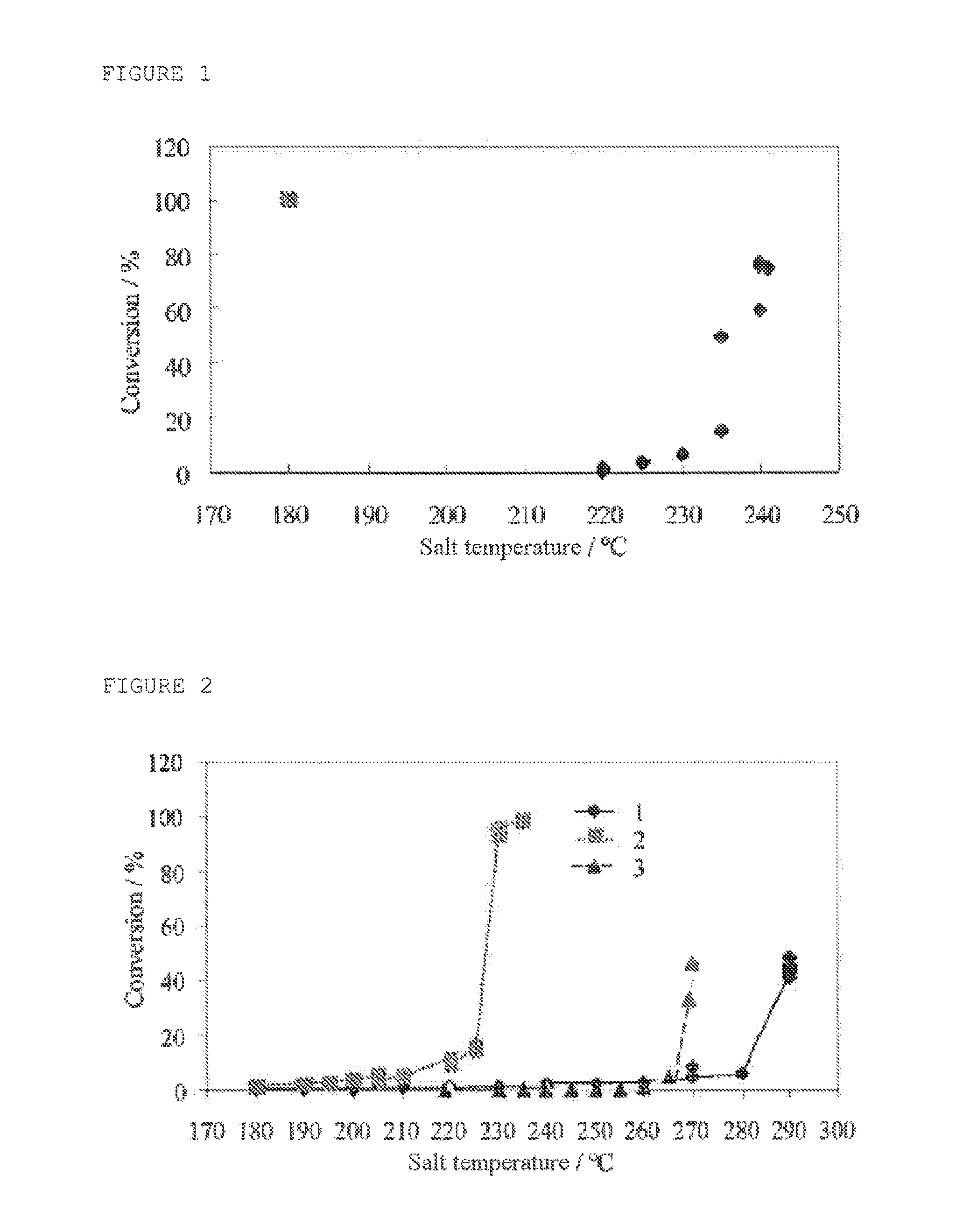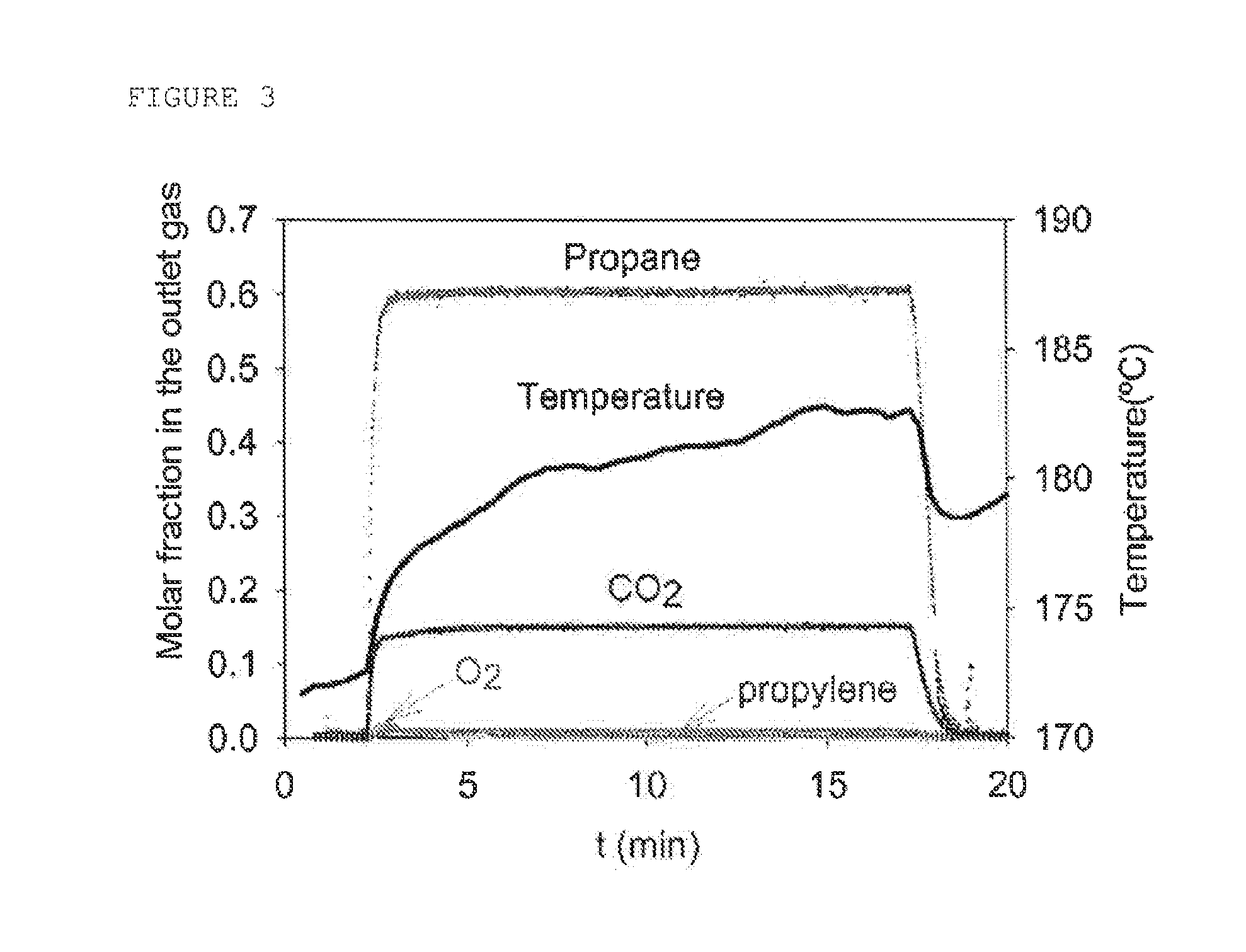Process for the selective oxidation of carbon monoxide
a carbon monoxide and selective oxidation technology, which is applied in the direction of catalyst activation/preparation, metal/metal-oxide/metal-hydroxide catalysts, chemical production, etc., can solve the problem of large cosub>2 /sub>emission into the atmosphere, carbon monoxide being flammable, and carbon monoxide having a harmful effect on oxidation catalysts, etc. problem, to achieve the effect of no longer destroying, reducing
- Summary
- Abstract
- Description
- Claims
- Application Information
AI Technical Summary
Benefits of technology
Problems solved by technology
Method used
Image
Examples
example 1
[0078]Oxidation tests were carried out on pure compounds using a catalyst from Johnson Matthey (2% Pt on CeO2) in a reactor comprising a bath of molten salt, with an internal diameter of 25.4 mm and with a catalyst height of 30 cm (i.e., 164 g).
[0079]The test consisted in monitoring the conversion of the pure compound (conversion test where each constituent is tested individually) in a mixture of nitrogen and oxygen (3 mol %). For some tests, a portion of the nitrogen was replaced by water (20 mol %). The following concentrations (which represent the order of magnitude of the concentrations expected for each of the reactants in a real stream) were tested under SV conditions of 25 000 h−1, the conversion of the compound being determined as a function of the temperature:[0080]CO: 2.8 mol %[0081]Propylene: 0.75 mol %[0082]Acrolein: 0.75 mol %[0083]Propane: 50 mol %[0084]optionally water
[0085]These conditions correspond to conditions for the oxidation of propylene in the presence of pro...
example 2
Comparative
[0089]Example 1 is reproduced with the fixed bed of catalyst and a stream comprising the mixture of the compounds CO, CO2, propane, propylene, acrolein, water and oxygen with the following concentrations, in which it is desired to selectively oxidize the CO to CO2:[0090]CO: 2.8 mol %[0091]Propylene: 0.75 mol %[0092]Acrolein: 0.75 mol %[0093]Water: 20 mol %[0094]Oxygen: 3 mol %[0095]Propane: 50 mol %
[0096]The tests carried out show that, in the presence of the mixture of compounds, complete combustion of the reactants is observed as long as the oxygen is available, in the following order of reactivity:[0097]CO>propylene>acrolein>propane
[0098]The temperature is not controlled: a hot spot can be measured where the temperature reached in the catalytic bed is greater by 150° C. at least than that of the oven. Consequently, this difference being much greater than that measured between the ignition temperatures of the pure substances, all the oxidation reactions are stressed at ...
example 3
Preparation of Catalysts for the Selective Oxidation of Carbon Monoxide
Preparation of a Catalyst A
[0101]200 g of porous silica spheres with a diameter of 80 microns are impregnated, by nascent humidity impregnation, with a solution comprising 10.2 g of citric acid, 20.2 g of tetraammineplatinum(II) hydrogencarbonate (comprising 50.6% of platinum), 8 g of iron(III) nitrate nonahydrate and 103.5 g of demineralized water. Gentle heating with stirring is used to evaporate the excess water, the solid being kept rotated in a rotating oven in order to prevent, agglomeration. Finally, the powder is dried at 105° C. and then calcined under air at 500° C. for 2 hours.
Preparation of a Catalyst B
[0102]A catalyst is prepared by impregnation of Puralox® SCCA 5-150 alumina from Sasol according to the following protocol:
[0103]300 g of alumina are introduced into a 3 l jacketed reactor heated to 100° C. and flushing with air is carried out in order to fluidize the alumina. A solution of 15.3 g of ci...
PUM
| Property | Measurement | Unit |
|---|---|---|
| particle size | aaaaa | aaaaa |
| particle size | aaaaa | aaaaa |
| molar ratio | aaaaa | aaaaa |
Abstract
Description
Claims
Application Information
 Login to View More
Login to View More - R&D
- Intellectual Property
- Life Sciences
- Materials
- Tech Scout
- Unparalleled Data Quality
- Higher Quality Content
- 60% Fewer Hallucinations
Browse by: Latest US Patents, China's latest patents, Technical Efficacy Thesaurus, Application Domain, Technology Topic, Popular Technical Reports.
© 2025 PatSnap. All rights reserved.Legal|Privacy policy|Modern Slavery Act Transparency Statement|Sitemap|About US| Contact US: help@patsnap.com


